
Decoding Fish Immunity: How Yellow Croaker's 'LcIFNc' Could Revolutionize Aquaculture
"A new study uncovers the potent antiviral properties of LcIFNc in large yellow croakers, offering a promising solution for disease management in aquaculture."
In aquaculture, viral infections pose a significant threat, leading to substantial economic losses and environmental concerns. As such, scientists are researching innovative strategies to bolster the immune defenses of farmed fish.
Teleost fish, like mammals, possess interferons (IFNs), which are critical proteins that fight off pathogens. The study of fish IFNs has been a growing area of interest, as it promises potential breakthroughs for aquaculture.
Recent research has identified a novel type I interferon, LcIFNc, in large yellow croakers (Larimichthys crocea). This discovery could unlock new methods for disease prevention and management in aquaculture.
LcIFNc: A Powerful Antiviral Agent

The study identifies and characterizes LcIFNc, a group II type I interferon in large yellow croakers. This protein contains six cysteines, of which four are highly conserved, that are essential for immune function. LcIFNc is found to be constitutively expressed in various tissues, indicating its baseline importance.
- Increased expression of antiviral genes (Mx1, PKR, ISG15) in peripheral blood leukocytes (PBLs).
- Reduced cytopathic effect (CPE) and decreased viral gene expression in grouper spleen (GS) cells.
- Induction of LcIFNc, LcIFNd, and LcIFNh expression in PBLs and primary head kidney cells (HKCs).
Future Directions and Implications
Further research is needed to fully understand the mechanisms of action of LcIFNc and its interactions with other immune components. Identifying the specific pathways through which LcIFNc mediates its antiviral effects could pave the way for targeted immunotherapies.
Aquaculture practices could benefit from the inclusion of LcIFNc-based strategies to enhance disease resistance. Selective breeding programs could focus on enhancing natural LcIFNc expression in fish populations.
The findings from this research could be extended to other commercially important fish species, providing a broader impact on global aquaculture practices. The study of fish immunology could lead to strategies to minimize disease outbreaks and enhance productivity.
